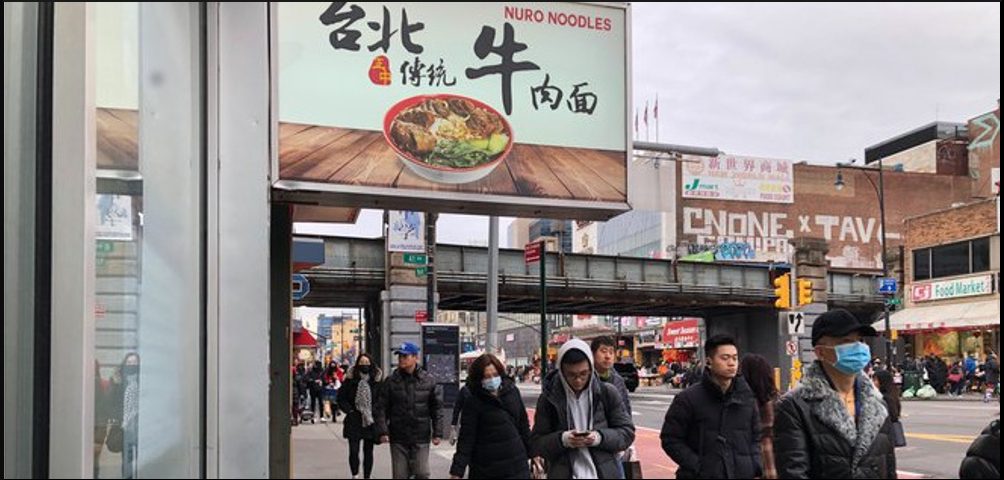by Joshua Cho, published on FAIR (Fairness and Accuracy in Reporting), March 6, 2020
As an Asian-American, I’m not surprised that there are numerous reports surfacing of racist and xenophobic responses arising in the US (and elsewhere) as a result of the coronavirus outbreak, where “coughing while Asian” is being compared to “driving while black.” In case there are any doubts that media coverage is being racialized, reports about new coronavirus updates in the US, particularly in areas like New York City, are using unrelated header images of East Asian people wearing face masks to drive the impression that Chinese people are unique carriers of disease, even when they aren’t Chinese.
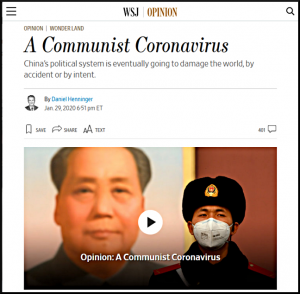 Watching corporate media’s sensationalist and racist coverage of the COVID-19 coronavirus, it’s clear that everything from the naming of the “Wuhan coronavirus,” to the false narrative and timeline propagated by corporate media to demonize China’s handling of the coronavirus outbreak, does more to stoke mass hysteria and undermine a US adversary than to show support and solidarity with the Chinese people. In short, it’s the same old Yellow Peril and redbaiting nonsense US media have always engaged in.
Watching corporate media’s sensationalist and racist coverage of the COVID-19 coronavirus, it’s clear that everything from the naming of the “Wuhan coronavirus,” to the false narrative and timeline propagated by corporate media to demonize China’s handling of the coronavirus outbreak, does more to stoke mass hysteria and undermine a US adversary than to show support and solidarity with the Chinese people. In short, it’s the same old Yellow Peril and redbaiting nonsense US media have always engaged in.
Corporate media’s typical framing of Chinese government actions to combat the virus verged on parody, portraying uncontroversial moves in the most insidious terms possible. For example, instead of reporting that Hubei government officials were fired for withholding information about the coronavirus outbreak from higher-ups, outlets like CNN (2/13/20) and Business Insider (2/11/20) claimed they were “purged.” Discussing volunteer efforts to assist China’s effective quarantine efforts, the New York Times’ “To Tame Coronavirus, Mao-Style Social Control Blankets China” (2/15/20) framed it as “one of the biggest social control campaigns in history,” and described “neighborhood busybodies” and “uniformed volunteers” aiding the quarantine efforts as “Mao-style mass crusades.”
Corporate media bombarded Western audiences with loaded headlines whose point was that Communism was evil and the coronavirus outbreak the inevitable result of peculiar Asian attachments to authoritarianism.
The Wall Street Journal ran op-eds like “A Communist Coronavirus” (1/29/20) and “China Is the Real Sick Man of Asia” (2/3/20), which gleefully claimed that the “mighty Chinese juggernaut has been humbled” by a “species-hopping bat virus,” and argued that the “Wuhan coronavirus is a metaphor” for “the Communist Party of China” and “American isolationism” being ideas that are “incompatible with the modern world.”
Another Times report, “Coronavirus Crisis Exposes Cracks in China’s Facade of Unity” (1/28/20), played into the ludicrous “imminent collapse” of the Chinese government trope, by claiming that the coronavirus outbreak has “blown up” the “facade” of a “gradually unifying society,” and that the “cracks” showing in “China’s veneer of stability” reveal that China “remains riddled with vulnerabilities that no amount of censorship or strong-arming can hide.”
The Times’s Nicholas Kristof (1/29/20) argued that “we’re seeing the dangers of Xi’s authoritarian model, for China and the world,” because of “Xi’s China” systematically gutting institutions like journalism, social media and NGOs (avenues typically exploited by the US to subvert targeted governments and spread pro-American propaganda).
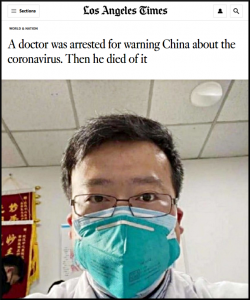 The Times (1/25/20) reported that “officials in Wuhan and around the country withheld critical information, played down the threat and rebuked doctors who tried to raise the alarm,” which should raise questions about “weaknesses at the very heart of the Chinese system”: China’s “rigidly hierarchical bureaucracy” and “quasi-imperial system” discourage “local officials from raising bad news with central bosses,” as “top party bosses in Beijing” have “little direct power over what happens in the provinces.”
The Times (1/25/20) reported that “officials in Wuhan and around the country withheld critical information, played down the threat and rebuked doctors who tried to raise the alarm,” which should raise questions about “weaknesses at the very heart of the Chinese system”: China’s “rigidly hierarchical bureaucracy” and “quasi-imperial system” discourage “local officials from raising bad news with central bosses,” as “top party bosses in Beijing” have “little direct power over what happens in the provinces.”
Because a novel virus emerged in a rival state, it doesn’t logically follow that that government should collapse, or that the US should therefore be more imperialist. But corporate media use these tortured syllogisms, serving as mouthpieces for the US government.
USA Today ran an op-ed (2/12/20) by Republican Sen. Ben Sasse claiming that the “coronavirus disaster” is the “deadly consequence” of Xi and the Chinese Communist Party’s “malfeasance and misrule,” with “Communism” being the “perfect incubator for the coronavirus.” Both Sasse and the Times’ Kristof claim that this is so because the Chinese government allegedly silenced “whistleblowers” like Dr. Li Wenliang, which prevented him from alerting the public about the novel coronavirus. (Meanwhile, the United States has held Chelsea Manning, perhaps its most prominent whistleblower, in jail for nearly a year for refusing to testify in the case of Julian Assange, who the US has indicted as a spy for publishing government secrets.)
Virtually all of corporate media’s false narrative of the coronavirus outbreak hinge upon the story of Li being a “martyr” and “whistleblower” who allegedly “discovered” the coronavirus, but was silenced and “arrested” by government officials before he could alert the public.
But as several people have already documented at length, while Dr. Li’s death is tragic, he was not a whistleblower. In fact, the Times’ own “reconstruction of the crucial seven weeks between the appearance of the first symptoms in early December and the government’s decision to lock down the city” (2/1/20) disproves the corporate media narrative of authoritarian secrecy to maintain “control” over unrest. Li wasn’t a virologist or epidemiologist treating affected patients; he was an ophthalmologist who treated eye problems, which might be why he incorrectly claimed that the new virus was SARS, a related but different coronavirus.
A whistleblower is someone who tries to alert the public about wrongdoing on the part of individuals or an organization; Li didn’t consider himself to be one, and didn’t want his December 30 posting in a private WeChat group to be shared with anyone else. Neither were Li and his colleagues “arrested,” as several sensationalist reports falsely claimed without issuing retractions, as the Wall Street Journal (2/7/20) did:
Dr. Li Wenliang was taken in by police and questioned after telling former classmates about a cluster of pneumonia cases. An earlier version of this article mistakenly said Dr. Li Wenliang had been arrested.
Li was told by the police on January 3 not to spread unverifiable rumors—after a screenshot was leaked on December 31—because false information could set off unnecessary panic during the Spring Festival (one of the busiest and most important holidays of the year), as at the time there had been no fatalities and no clear evidence of human-to-human transmission. According to the prestigious New England Journal of Medicine’s timeline (1/29/20), the full genomic sequence wasn’t isolated and shared until January 10, and the first fatality occurred on January 9—with most of the fatalities occurring among older people with co-morbidities—and the first confirmed case outside China was reported on January 13.
More importantly, the Red Scare coverage above completely erased the fact that the “whistle” had already been blown by Dr. Zhang Jixian, the first doctor to report the novel coronavirus to health authorities on December 27, which resulted in an announcement by the Chinese Center for Disease Control (CDC) and the Wuhan Health Commission (WHC) earlier on December 30, the same day Li texted his seven colleagues (Global Times, 2/6/20). Zhang wasn’t suppressed by the government, but rather commended for her efforts.
The Los Angeles Times (2/16/20) seemed to imply that the coronavirus epidemic was a positive development, insofar as it stripped Xi Jinping’s “aura of invincibility in ways that no political dissident, opposition party or revolutionary movement ever could,” and because “his inability to contain it” could lead to growing dissent and skepticism towards his “form of techno-authoritarianism.”
The LA Times even managed to sneak in references to “ancient notions” of a “mandate of heaven construct,” with “Confucian thinking and forms of deeply rooted superstition” holding “widespread sway,” as a potential explanation for why Chinese people might not realize that Xi and the Communist Party don’t have the support of “mysterious forces in heaven.”
A less racist and propagandistic explanation for why more Chinese people aren’t rebelling against the Chinese government would be the fact that, alongside its repressive institutions, it has continually raised their standards of living, an accomplishment reflected in the high levels of public trust expressed in surveys.
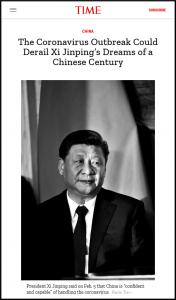 As Michael Parenti noted in Against Empire, corporate media demonize the leaders of official enemy states as an evil personification of the entire population, who is then used to justify US hostility against them. This is readily apparent in corporate media’s predominant framing of the coronavirus as a problem for “Xi Jinping,” or the “Communist Party” (New York Times, 1/26/20; Time, 2/6/20; Wall Street Journal, 2/7/20; Foreign Policy, 2/10/20; Foreign Affairs, 2/10/20), rather than for the Chinese people and those suffering from the virus abroad, or as a problem for the international community to solve cooperatively with China.
As Michael Parenti noted in Against Empire, corporate media demonize the leaders of official enemy states as an evil personification of the entire population, who is then used to justify US hostility against them. This is readily apparent in corporate media’s predominant framing of the coronavirus as a problem for “Xi Jinping,” or the “Communist Party” (New York Times, 1/26/20; Time, 2/6/20; Wall Street Journal, 2/7/20; Foreign Policy, 2/10/20; Foreign Affairs, 2/10/20), rather than for the Chinese people and those suffering from the virus abroad, or as a problem for the international community to solve cooperatively with China.
CNN (2/11/20) criticized Xi’s visit to treatment centers as a “stage-managed outing,” scorning the president for never “being at any risk of infection,” and refusing to place himself in a situation “where his health was under threat,” based solely on the kind of face mask he was using! Apparently, the proper way for a foreign head of state to seriously deal with an epidemic is to contract and overcome the disease themselves at the risk of their own life.
The New York Times’ “Coronavirus Outbreak Risks Reviving Stigma for China” (2/10/20) offered plausible deniability by claiming that “old stereotypes” of China being a “source of contagion” are “unfounded” and “outdated,” before subtly playing into the racist trope of dirty Asians by retaining claims that “China’s recent history of what are known as zoonotic infections” raise “questions about public-health practices in the world’s most populous country,” because, “China remains somewhat of a laboratory itself,” according to the RAND Corporation’s Dr. Jennifer Huang Bouey:
“There is quite a fair amount of epidemics originating in China or passing through China,” she said…. Two of the devastating flu pandemics of the 20th century — the Asian flu of 1957 and the Hong Kong flu of 1968 — both originated in China and left a trail of about 3 million deaths worldwide.
International authorities and leading medical professionals don’t share US corporate media’s negative assessment. UN Secretary General Antonio Guterres praised China’s efforts to contain the epidemic as “remarkable,” and warned against stigmatizing the country. The World Health Organization (WHO) has repeatedly lauded China’s remarkable transparency and mobilization of resources, despite corporate media flak, and declared China to be setting “a new standard” for its “unprecedented” response, and has criticized what it called an “infodemic” of overabundant and false information.
The Lancet (1/24/20), a leading British medical journal, shared this positive assessment of China’s efforts, praising WHO for not bowing to the “pressure” of “massive attention and conjecture” to declare a Public Health Emergency of International Concern (PHEIC) “until necessary.” It published an open letter expressing solidarity with Chinese officials and health professionals combating the disease.
Journalist Patrick Cockburn (Independent, 1/24/20) observed that the need to blame somebody, the spread of misinformation and suspicion of assurances provided by authorities, are common features of epidemics, because it’s difficult for governments to convey a sense of calm and emergency at the same time.
Corporate media provide relentless reports on new outbreak and mortality figures without providing comparisons to other common diseases and previous epidemics, with headlines like the Washington Post’s “South Korea Coronavirus Cases Surge as Italy Confirms First Death From the Virus” (2/21/20), the New York Times’ “Deaths in China Surpass Toll From SARS” (2/9/20) and USA Today’s “Death Toll From Coronavirus Surpasses 1,100; US Confirms 13th Case” (2/19/20). Virtually all of these kinds of reports include comparisons with previous epidemics surfacing in China, like SARS, but scrupulously avoid making comparisons with more familiar—and devastating—diseases like influenza, and epidemics originating in the US like the H1N1 swine flu.
For example, when Business Insider (3/6/20) reported that there are over 100,000 cases of people infected with the coronavirus, with over 3,400 fatalities worldwide, it omitted that the flu infects and kills far more people every year. Although it’s true that the coronavirus has a higher fatality rate (about 0.1%, compared to coronavirus’ 3.4%), it’s also true that the flu is much more infectious and kills far more people. In the winter of 2017–18 for the US alone, a worse than usual year, it’s estimated that the flu killed 80,000. So far in the 2019–20 season, there have been at least 32 million to 45 million flu infections in the US, and 18,000 to 46,000 deaths. Worldwide, the flu kills around 650,000 people every year, yet many US adults are so complacent about the flu that only 45% of them bother to get the annual flu vaccination.
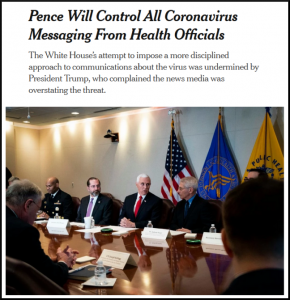 When US media criticize China for taking a month to declare an emergency, they omit that when H1N1 first appeared in the US in 2009, it took the US government six months to declare an emergency, and is estimated to have killed between 150,000 and 575,000 people worldwide in its first year. Curiously, corporate media didn’t consider that an opportunity to question the legitimacy of capitalism or the US government for their handling of these diseases, or raise criticisms of US censorship (FAIR.org, 4/16/19).
When US media criticize China for taking a month to declare an emergency, they omit that when H1N1 first appeared in the US in 2009, it took the US government six months to declare an emergency, and is estimated to have killed between 150,000 and 575,000 people worldwide in its first year. Curiously, corporate media didn’t consider that an opportunity to question the legitimacy of capitalism or the US government for their handling of these diseases, or raise criticisms of US censorship (FAIR.org, 4/16/19).
Nor do outlets like the New York Times (2/27/20) raise alarms about US “authoritarianism” when it reported on the Trump administration’s censorship of leading scientists warning about coronavirus, like it previously has on climate change, in order to “tighten control of coronavirus messaging by government health officials and scientists,” and having them “coordinate all statements and public appearance with the office of Vice President Mike Pence.”
US media hysteria is especially hypocritical, as virtually all of these reports condemning China’s response omit criticisms of US preparedness for epidemics (which is far worse), and the Trump administration previously firing the US government’s pandemic response chain of command, while cutting funding for disease prevention programs.
However, this threat inflation and opportunistic fearmongering toward official enemies is par for the course for corporate media. Oxford’s Our World in Data project found huge discrepancies between what Americans actually die from (cancer and heart disease), and what media reports emphasize as the cause of US deaths (homicide and terrorism). Perhaps this sensationalist Yellow Peril and Red Scare coverage over the coronavirus are the result of the US government seeing China itself and its challenging socialist system as viruses that need to be “contained.”
*Featured image: Gothamist photo (1/31/20) of Asian Americans wearing surgical masks, illustrating a story about the absence of coronavirus (at that point) in New York City.
Joshua Cho is a writer based in Virginia.
